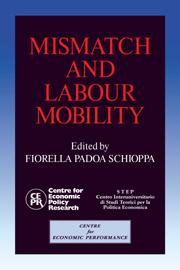Book contents
- Frontmatter
- Contents
- List of figures
- List of tables
- Preface
- Acknowledgements
- List of conference participants
- 1 A cross-country comparison of sectoral mismatch in the 1980s
- 2 Mismatch: a framework for thought
- Discussion
- 3 Match and mismatch on the German labour market
- Discussion
- 4 Mismatch in Japan
- Discussion
- 5 Mismatch and internal migration in Spain, 1962–86
- Discussion
- 6 Regional inequalities, migration and mismatch in Italy, 1960–86
- Discussion
- 7 Skill shortages and structural unemployment in Britain: a (mis)matching approach
- Discussion
- 8 Labour market tightness and the mismatch between demand and supply of less-educated young men in the United States in the 1980s
- Discussion
- 9 Skill mismatch, training systems and equilibrium unemployment: a comparative institutional analysis
- Discussion
- 10 Unemployment, vacancies and labour market programmes: Swedish evidence
- Discussion
- 11 Mismatch and labour mobility: some final remarks
- Index
10 - Unemployment, vacancies and labour market programmes: Swedish evidence
Published online by Cambridge University Press: 05 October 2010
- Frontmatter
- Contents
- List of figures
- List of tables
- Preface
- Acknowledgements
- List of conference participants
- 1 A cross-country comparison of sectoral mismatch in the 1980s
- 2 Mismatch: a framework for thought
- Discussion
- 3 Match and mismatch on the German labour market
- Discussion
- 4 Mismatch in Japan
- Discussion
- 5 Mismatch and internal migration in Spain, 1962–86
- Discussion
- 6 Regional inequalities, migration and mismatch in Italy, 1960–86
- Discussion
- 7 Skill shortages and structural unemployment in Britain: a (mis)matching approach
- Discussion
- 8 Labour market tightness and the mismatch between demand and supply of less-educated young men in the United States in the 1980s
- Discussion
- 9 Skill mismatch, training systems and equilibrium unemployment: a comparative institutional analysis
- Discussion
- 10 Unemployment, vacancies and labour market programmes: Swedish evidence
- Discussion
- 11 Mismatch and labour mobility: some final remarks
- Index
Summary
Introduction
Research on European unemployment over the past two decades has frequently claimed that European labour markets have become less ‘flexible’. Evidence of more severe labour market rigidities is often revealed by outward shifts of the Beveridge curve – i.e., the relationship between unemployment and vacancy rates (the u/v curve). The British experience of a huge increase in unemployment at given vacancy rates is especially striking, but outward shifts of the Beveridge curve have been typical rather than exceptional in Europe since the early 1970s. As a broad generalisation, it seems as if labour markets with substantial increases in unemployment have experienced outward u/v shifts as well. In contrast to what has happened in most other European countries, the u/v curve in Sweden has proved to be a relatively stable relationship since the late 1960s.
The interpretations of u/v shifts have been diverse and often tentative; hypotheses of increasing sectoral imbalances across industries, regions, or occupations (‘mismatch’) have been launched, but found only limited support (Jackman and Roper, 1987). Other researchers have paid attention to declining search effort and the role of long-term unemployment (Budd, Levine and Smith, 1988; Jackman, Layard and Pissarides, 1989).
This study focuses on the role of labour market programmes in the process of matching workers and jobs in the Swedish labour market; labour market policies come in many guises, but it is useful for our purposes to ignore the differences and focus on the common features. The programmes are arrangements whereby the government attempts to cushion labour market shocks, and they may also involve training in order to facilitate future employment prospects; the Swedish temporary public jobs (‘relief jobs’) and manpower training programmes are obvious examples.
- Type
- Chapter
- Information
- Mismatch and Labour Mobility , pp. 405 - 448Publisher: Cambridge University PressPrint publication year: 1991
- 14
- Cited by



